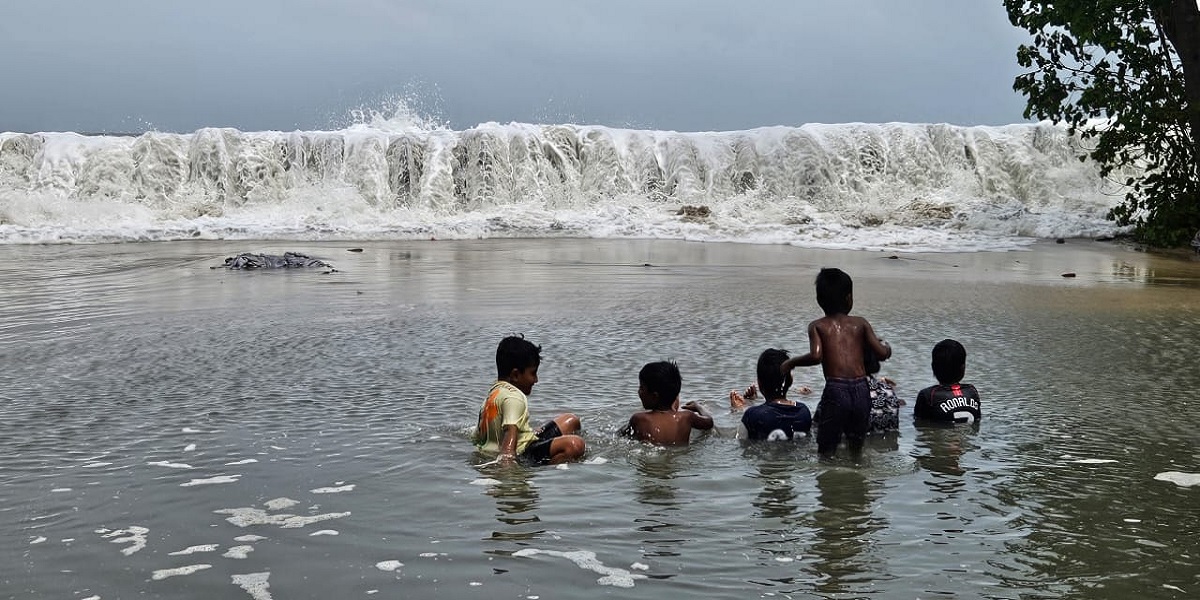Unlike coastal communities in districts such as Kollam or Thiruvananthapuram, where many residents live in small houses or lack formal land documents, Chellanam families have invested their lifetime savings in concrete homes. After each sea flood, repairs are necessary, and finding safe land for relocation is a challenge.
Published Oct 08, 2025 | 9:00 AM ⚊ Updated Oct 24, 2025 | 12:05 PM

Children in Chellanam play in the sea's floodwaters while their homes stay under water.
Synopsis: Residents of Chellanam, a coastal village in Kochi, must contend with the repeated invasion of their homes by the sea each year. Despite the state’s housing initiatives being successful elsewhere, several factors unique to Chellanam, compounded by the social, economic, and gendered implications for the fishing community, have made relocation difficult for its residents.
Gracy Pious is not just a house-help in several apartments in Edappally, Kochi. She takes on the role of an aunt, an elder sister, and on some days even a mother to a three-year-old child, depending on the work shifts of the IT couples she supports.
Her days are spent running from one flat to another, working tirelessly to keep the homes of others in order.
After hours of exhausting work, she boards a crowded, rattling private bus in the late evening, heading back to Chellanam village, a suburb of Kochi. There, two children wait for her in a house by the sea.
Even though Gracy earns a modest but steady income, it has never translated into progress. Every year, sometimes twice, her earnings are swallowed by repairs—the mixer, the fridge, the wiring, the very foundation of her home—in a losing battle with the sea as it invades the house time and again.
Each storm, each wave threatens to take it all, just as it has for so many of her neighbours.
Outsiders often ask the simplest, most painful question: “Why don’t they move into the government-provided houses? Why not apply for a new home?” The reality is much more complicated.
In August, the Kerala government handed over 332 newly built homes at Muttathara, Thiruvananthapuram, to families from highly vulnerable coastal stretches. This is part of Punargeham, a state-led relocation initiative to protect fishing communities facing climate change-driven sea erosion and displacement.
With thousands of households living inside the fragile 50-metre belt from the high-tide line, the government set out to move 22,174 families to safer ground. Approved in February 2022, the programme has been rolled out in phases and made significant strides within three years.
Anchored under the LIFE Mission, Punargeham was one of the Left Democratic Alliance’s (LDF) flagship election pledges in 2021, with a sanctioned budget of ₹2,450 crore.
So far, around 9,104 families have expressed willingness to relocate. Of these, 4,421 families have secured land and received the green light from district-level committees, while 2,488 have already completed construction of their new homes.
The project has seen tangible progress across multiple districts. Apartment complexes have been allotted at Karode (128 units), Beemapally (20 units), QSS Colony in Kollam (114 units), and Ponnani in Malappuram (128 units), resettling 2,878 families and providing safer living conditions for 5,361 individuals.
Yet Chellanam stands apart. Unlike other coastal belts, the crisis here is more complex and deeply tied to the peculiarities of its land. Despite the state’s large-scale efforts, the people of Chellanam continue to struggle without secure housing.
Apart from the LIFE and Punargeham projects, there is currently no special housing package for fisherfolk, according to Chellanam Panchayat president Joseph KL.

CM Pinarayi Vijayan handing over keys to fisherfolk flats under the ‘Punargeham’ project last August.
The panchayat has nearly 11,000 houses in total. Cyclone Tauktae in 2021 caused severe damage in the region.
Under the LIFE Mission (2021–2025), 474 houses have been approved in Chellanam Panchayat, of which 378 are already completed. Paperwork for the remaining houses has been finalised. Not every ward in the panchayat is affected by sea flooding; the main areas constantly battling the sea are Puthenthode, Kannamaly, Companyppady, and others.
Financial assistance is provided to residents to repair homes after damage assessment, ranging from ₹15,000 to ₹95,000.
A key limitation of the Punargeham project is that it provides a maximum of ₹10 lakh per family, which may be insufficient if land values are higher. Relocation options are also limited since around 90 percent of residents are fisherfolk who depend on coastal areas.
Recently, the Kochi Corporation opened the Thuruthy Housing Complex in Fort Kochi, providing modern flats for 394 families from Mattancherry who previously lived in Kalvathy, Koncheri, and Thuruthy colonies.
Such large-scale construction is not feasible in Chellanam due to sensitive soil conditions, which make it unsuitable for bigger apartments.
In Chellanam, many residents have been hesitant to participate in the Punargeham relocation project, even when offered new homes on safer land. VT Sebastian, a local activist, explained that a major reason is the high value of the land people already own.
“Most people in Chellanam own registered land, which has significant value – often higher than the ₹10 lakh offered under the Punargeham project. Many hesitate to leave their homes for relocation,” Sebastian told South First.
Unlike coastal communities in districts such as Kollam or Thiruvananthapuram, where many residents live in small houses or lack formal land documents, Chellanam families have invested their lifetime savings in concrete homes. After each sea flood, repairs are necessary, and finding safe land for relocation is a challenge.
Land prices in Kochi further complicate the issue. According to Sebastian, “With ₹6 lakh, even 3 cents of land is unaffordable. Payments under the project are made directly to sellers after submitting the required documents, so the cash doesn’t reach the beneficiaries. The remaining ₹4 lakh must cover house construction, often without loans – something many fear due to seasonal incomes from fishing.”
The project also imposes strict restrictions on land and property use. Families can only take 5 cents under Punargeham, and any extra land must remain as open space.
“We couldn’t even plant anything. If we want to pursue agriculture, Krishi Bhavan decides which crops we are allowed to cultivate. Also, the right to resell the property was only granted after several more years. Many residents fear these restrictions. Only families with steady income and financial backup opted for relocation and moved to cities for other jobs,” Sebastian said.
Regulatory constraints add another layer of complexity. Coastal lands in Chellanam fall under the National Coastal Regulation Zone (CRZ) Notification, 2019, and the state-specific Coastal Zone Management Plan (CZMP). High population density led to Chellanam being reclassified from CRZ-III to CRZ-III A in 2015, reducing the No Development Zone (NDZ) from 200 metres to 50 metres from the High Tide Line (HTL).
Construction within the NDZ is restricted, although repairs to existing structures are allowed. Beyond the 50-metre zone, regulated construction is permitted under local planning rules, but new or reconstructed residential buildings are limited to two floors (ground plus one floor) and a maximum height of nine metres.
A climate researcher based in Kochi highlighted the severe threats Kerala’s coastal communities face due to climate change. The Ministry of Environment and Forests report to the UN Framework Convention on Climate Change notes that rising sea levels pose the greatest risk.
Kerala’s State Action Plan on Climate Change (SAPCC) estimates a sea level rise of 100–200 mm over the next century. A one-metre rise could submerge 169 sq. km around Kochi, contaminate groundwater, and degrade marshlands.
The National Centre for Sustainable Coastal Management reports that 63 percent of Kerala’s coastline is experiencing erosion, threatening thousands of families. Coastal communities, particularly fishers, are highly vulnerable due to dense populations along the 590 km coastline. Hundreds of families have already lost homes to erosion in the past five years.
Suja Bharathy, a social activist, told South First that relocation policies risk disrupting the tight-knit social fabric of fishing communities. Beaches serve as centres for social and cultural life, but relocation often offers only 3–4 cents of land per family, limiting space for social activities.
Moving into areas primarily inhabited by non-fishers can lead to marginalisation. Families must also find land themselves, often further from the beach, making daily fishing operations difficult. Small-scale fishers rely on proximity to the shore to monitor the sea, launch boats quickly, and manage nets and engines – a challenge if relocated farther inland.
Relocation plans also overlook gender dynamics. Women’s livelihoods are tied to the coastal environment, and their economic activities and vulnerabilities need to be considered. Overall, the relocation dilemma reflects a conflict between life security and livelihood security, a persistent challenge for fishing communities.
(Edited by Dese Gowda)
